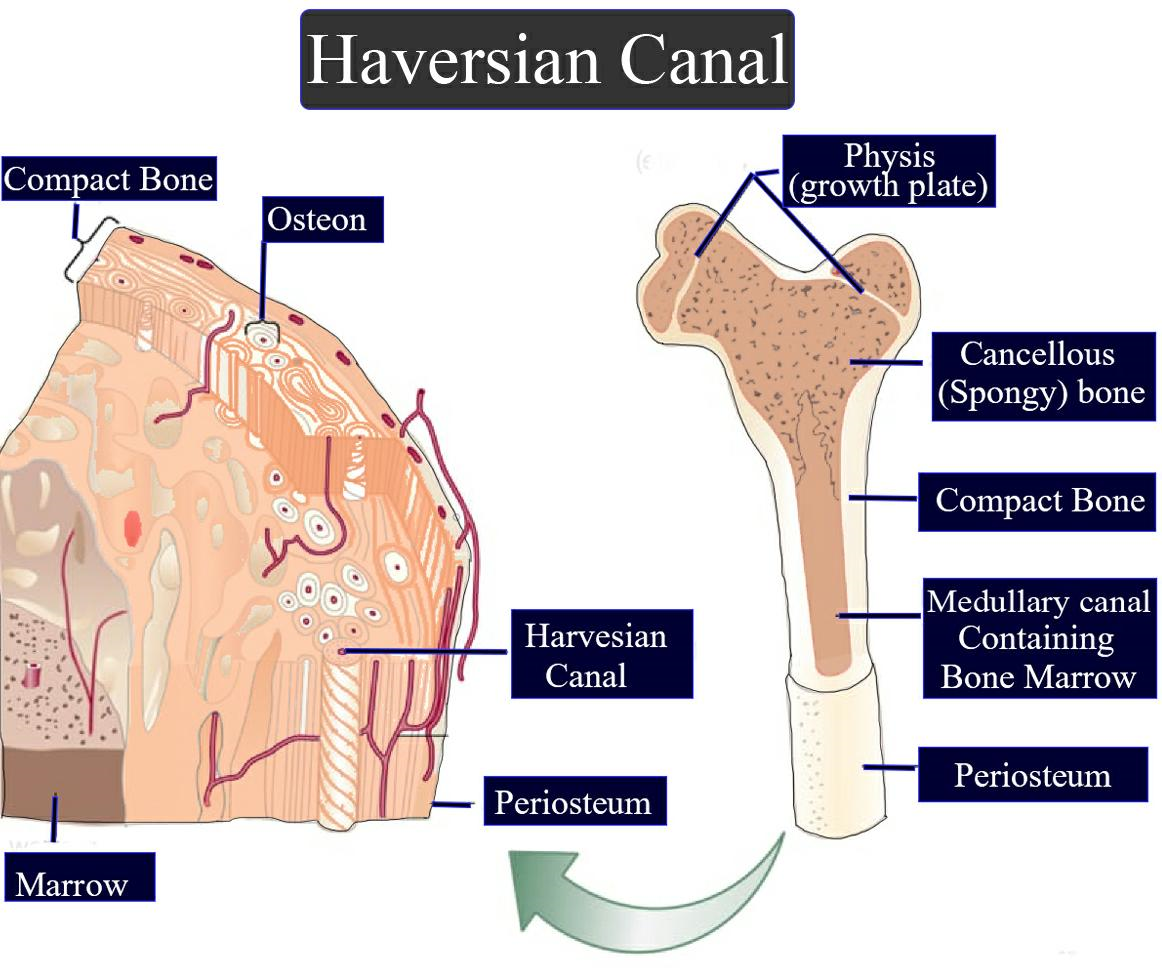
Haversian canal occurs in
(a)Humerus
(b)Pubis
(c)Scapula
(d)Nerves
Answer
487.8k+ views
Hint: This bone is found in mainly long bones of mammals that permit blood vessels and nerves to travel through them. The Haversian system helps in the passage of nutrients between the blood and bone.
Complete answer:
The Haversian canal occurs in the humerus bone whose outer side is made up of cortical bones. These bones are generally known as compact bones. The Haversian system is an elongated cylindrical structure that is organized parallel to the surface of the bone, along the long axis. Each haversian canal mainly comprises one or two capillaries and nerve fibers.
Structure of the haversian canal:
The osteon contains a central canal which is called a haversian canal. This canal is surrounded by concentric rings of the matrix. In between the rings of the matrix, the bone cells are located in dense spaces called lacunae. Small channels also known as canaliculi radiate from the lacunae to the haversian canal to communicate with bone cells. This unique arrangement facilitates the deposit and storage of mineral salts that gives bones their strength.
Additional information:
-Haversian canal comprises approximately 45% of the cortical bone.
-It also transports the oxygenated blood to the bone.
-The structural unit of a compact bone is known as the osteon or Haversian system.
-Haversian canals are a series of microscopic tubes.
So, the correct answer is ‘humerus’.
Note: -Osteoblasts are new bone-forming cells that contain a single nucleus. These cells come from bone marrow.
-Osteoclasts are the cells that break down the bone tissues. The main function of the cells is to resorb mineralized bone, dentine, and calcified cartilage.

Complete answer:
The Haversian canal occurs in the humerus bone whose outer side is made up of cortical bones. These bones are generally known as compact bones. The Haversian system is an elongated cylindrical structure that is organized parallel to the surface of the bone, along the long axis. Each haversian canal mainly comprises one or two capillaries and nerve fibers.
Structure of the haversian canal:
The osteon contains a central canal which is called a haversian canal. This canal is surrounded by concentric rings of the matrix. In between the rings of the matrix, the bone cells are located in dense spaces called lacunae. Small channels also known as canaliculi radiate from the lacunae to the haversian canal to communicate with bone cells. This unique arrangement facilitates the deposit and storage of mineral salts that gives bones their strength.
Additional information:
-Haversian canal comprises approximately 45% of the cortical bone.
-It also transports the oxygenated blood to the bone.
-The structural unit of a compact bone is known as the osteon or Haversian system.
-Haversian canals are a series of microscopic tubes.
So, the correct answer is ‘humerus’.
Note: -Osteoblasts are new bone-forming cells that contain a single nucleus. These cells come from bone marrow.
-Osteoclasts are the cells that break down the bone tissues. The main function of the cells is to resorb mineralized bone, dentine, and calcified cartilage.

Recently Updated Pages
The correct geometry and hybridization for XeF4 are class 11 chemistry CBSE

Water softening by Clarks process uses ACalcium bicarbonate class 11 chemistry CBSE

With reference to graphite and diamond which of the class 11 chemistry CBSE

A certain household has consumed 250 units of energy class 11 physics CBSE

The lightest metal known is A beryllium B lithium C class 11 chemistry CBSE

What is the formula mass of the iodine molecule class 11 chemistry CBSE

Trending doubts
Arrange Water ethanol and phenol in increasing order class 11 chemistry CBSE

Name the nuclear plant located in Uttar Pradesh class 11 social science CBSE

A mixture of o nitrophenol and p nitrophenol can be class 11 chemistry CBSE

Every party in India has to register itself with A class 11 social science CBSE

Describe the effects of the Second World War class 11 social science CBSE

What type of battery is a lead storage battery Write class 11 chemistry CBSE




